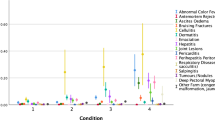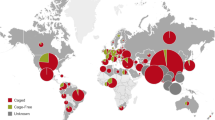Abstract
Intensive broiler (meat) chicken production now exceeds 800 million birds each year in the United Kingdom and 2 × 1010 birds worldwide1, but it attracts accusations of poor welfare2,3. The European Union is currently adopting standards for broilers aimed at a chief welfare concern—namely, overcrowding—by limiting maximum ‘stocking density’ (bird weight per unit area). It is not clear, however, whether this will genuinely improve bird welfare because evidence is contradictory4,5,6,7,8,9,10. Here we report on broiler welfare in relation to the European Union proposals through a large-scale study (2.7 million birds) with the unprecedented cooperation of ten major broiler producers in an experimental manipulation of stocking density under a range of commercial conditions. Producer companies stocked birds to five different final densities, but otherwise followed company practice, which we recorded in addition to temperature, humidity, litter and air quality. We assessed welfare through mortality, physiology, behaviour and health, with an emphasis on leg health and walking ability. Our results show that differences among producers in the environment that they provide for chickens have more impact on welfare than has stocking density itself.
This is a preview of subscription content, access via your institution
Access options
Subscribe to this journal
Receive 51 print issues and online access
$199.00 per year
only $3.90 per issue
Buy this article
- Purchase on Springer Link
- Instant access to full article PDF
Prices may be subject to local taxes which are calculated during checkout

Similar content being viewed by others
References
Scientific Committee on Animal Health and Animal Welfare The Welfare of Chickens Kept for Meat Production (Broilers) (European Commission, 2000)
Webster, J. Animal Welfare: a Cool Eye Towards Eden (Blackwell Scientific, Oxford, 1994)
Stevenson, P. The Welfare of Broiler Chickens (Compassion in World Farming, Petersfield, UK, 1995)
Bagshaw, C. S. & Matthews, L. R. Broiler Welfare–a Review of Latest Research and Projects in Progress Internationally (Ministry of Agriculture and Forestry, New Zealand, 2001)
Hall, A. The effect of stocking density on the welfare and behaviour of broiler chickens reared commercially. Anim. Welf. 10, 23–40 (2001)
Grashorn, M. & Kutritz, B. Effect of stocking density on performance of modern broiler breeds. Arch. Geflügelkd. 55, 84–90 (1991)
McLean, J. A., Savory, C. J. & Sparks, N. H. C. Welfare of male and female broiler chickens in relation to stocking density, as indicated by performance, health and behaviour. Anim. Welf. 11, 55–73 (2002)
Sørensen, P., Su, G. & Kestin, S. C. Effects of age and stocking density on leg weakness in broiler chickens. Poult. Sci. 79, 864–870 (2000)
Feddes, J. J. R., Emmanuel, E. J. & Ziudhoff, M. J. Broiler performance, body weight variance, feed and water intake and carcass quality at different stocking densities. Poult. Sci. 81, 774–779 (2002)
Heier, B. T., Hogasen, H. R. & Jarp, J. Factors associated with cumulative mortality in Norwegian broiler flocks. Prev. Vet. Med. 53, 147–165 (2002)
Farm Animal Welfare Council Report on the Welfare of Broiler Chickens (FAWC, Tolworth, UK, 1992)
Royal Society for the Prevention of Cruelty to Animals The RSPCA Welfare Standards for Chickens (RSPCA, Horsham, UK, 1995)
Broom, D. M. Indicators of poor welfare. Br. Vet. J. 142, 524–526 (1986)
Dawkins, M. S. in Coping with Challenge: Welfare in Animals including Humans (ed. Broom, D. M.) 63–78 (Dahlem Univ. Press, Berlin, 2001)
Mendl, M. Assessing the welfare state. Nature 410, 31–32 (2001)
Martrenchar, A., Boilletot, E., Huoinnic, D. & Pol, F. Risk factors for foot-pad dermatitis in chicken and turkey broilers in France. Prev. Vet. Med. 52, 213–226 (2002)
Ekstrand, C., Carpenter, T. E. & Andersson, I. Prevalence and prevention of foot pad dermatitis in broilers in Sweden. Br. Poult. Sci. 39, 318–324 (1998)
Kestin, S. C., Gordon, S., Su, G. & Sorenson, P. Relationships in broiler chickens between lameness, live-weight growth rate and age. Vet. Rec. 148, 195–197 (2001)
Bradshaw, R. H., Kirkden, R. D. & Broom, D. M. A review of the aetiology and pathology of leg weakness in broilers in relation to welfare. Avian Poult. Biol. Rev. 13, 45–103 (2002)
Weeks, C. A., Danbury, T. D., Davies, H. C., Hunt, P. & Kestin, S. C. The behaviour of broiler chickens and its modification by lameness. Appl. Anim. Behav. Sci. 67, 111–125 (2000)
Kristensen, E. K. M. & Wathes, C. M. Ammonia and poultry: a review. World's Poult. Sci. J. 56, 235–245 (2000)
Cockrem, J. F. & Rounce, J. R. Faecal measurements of oestradial and testosterone allow non-invasive estimation of plasma steroid concentrations in the domestic fowl. Br. Poult. Sci. 35, 433–443 (1994)
Denhard, M. et al. Measurement of plasma corticosterone and fecal glucocorticoid metabolites in the chicken (Gallus domesticus), the great cormorant (Phalacrocorax carbo), and the goshawk (Accipiter gentilis). Gen. Comp. Endocrinol. 131, 345–352 (2003)
Kemp, C. & Kenny, M. Ross Broiler Management Manual 36 (Aviagen, Newbridge, UK, 2002)
Reiter, K. & Bessei, W. Moglichkeiten zur Verringerung von Beinschaden bei Broilern und Puten (Ubersicht). Arch. Geflugelkd. 62, 145–149 (1998)
Whitehead, C. C. Nutrition and poultry welfare. World's Poult. Sci. J. 58, 349–356 (2002)
Kestin, S. C., Knowles, T. G., Tinch, A. F. & Gregory, N. G. The prevalence of leg weakness in broiler chickens and its relationship with genotype. Vet. Rec. 131, 190–194 (1992)
Gordon, S. H., Charles, D. R. & Green, G. Metabolic age: a basis for comparison of traditional breeds of meat chickens. Br. Poult. Sci. 42, S118–S119 (2001)
Acknowledgements
We thank Banham Poultry Ltd, Dove Valley (Ashbourne) Ltd, Faccenda Group (including Webb Country Food Group), Grampian Country Chicken, L&M Food Group, Moy Park Ltd, O'Kane Poultry Ltd, G. W. Padley Poultry Ltd, Rose Brand Poultry (including Skovsgaard) and Two Sisters Ltd (including Premier Farming) for participation; and P. Harvey for comments on the manuscript. We thank Defra for funding. M.S.D. conceived the project, made links with the companies, obtained funding, designed the protocols, ran the first trial, took part in about 25% of subsequent trials and largely wrote the paper. C.A.D. advised on the experimental design and undertook much of the statistical analysis. T.A.J. took over the running of the project from trial 2, collected and collated data from all subsequent trials, did the preliminary statistical analysis and collaborated in writing the paper.
Author information
Authors and Affiliations
Corresponding author
Ethics declarations
Competing interests
The authors declare that they have no competing financial interests.
Supplementary information
41586_2004_BFnature02226_MOESM1_ESM.doc
Supplementary Information: Management information, chick placement details, randomisation of stocking density, and correlation outcomes of the main variables with target stocking density effects. (DOC 136 kb)
Rights and permissions
About this article
Cite this article
Stamp Dawkins, M., Donnelly, C. & Jones, T. Chicken welfare is influenced more by housing conditions than by stocking density. Nature 427, 342–344 (2004). https://doi.org/10.1038/nature02226
Received:
Accepted:
Issue Date:
DOI: https://doi.org/10.1038/nature02226
This article is cited by
-
Robust LQR control based on multidimensional particle swarm optimization for enhancing the dynamic performance of poultry house system
International Journal of Dynamics and Control (2023)
-
Effect of different pasture species on welfare and behavior of slow-growing broiler chickens in free-range production system
Tropical Animal Health and Production (2023)
-
Impact of light stimulation during incubation on hatching traits and post-hatch performance of commercial broilers
Tropical Animal Health and Production (2021)
-
The effects of intermittent feeding and cold water on welfare status and meat quality in broiler chickens reared under daily heat stress
Tropical Animal Health and Production (2021)
-
Slow-growing broilers are healthier and express more behavioural indicators of positive welfare
Scientific Reports (2020)
Comments
By submitting a comment you agree to abide by our Terms and Community Guidelines. If you find something abusive or that does not comply with our terms or guidelines please flag it as inappropriate.



